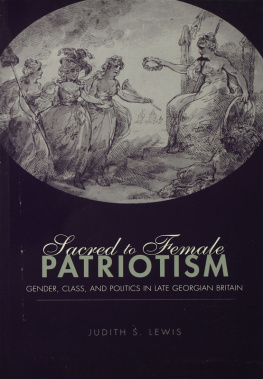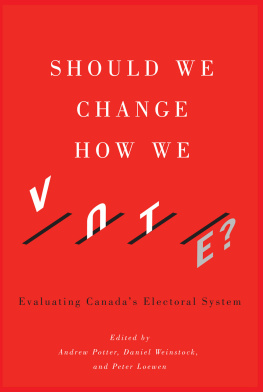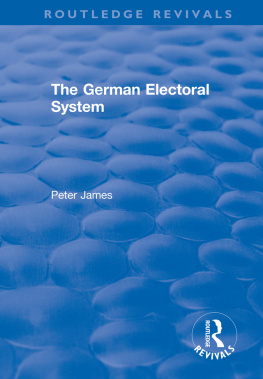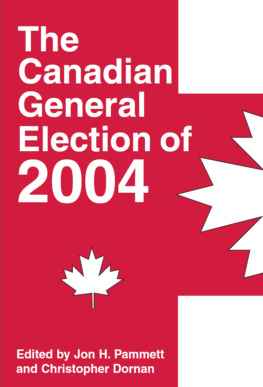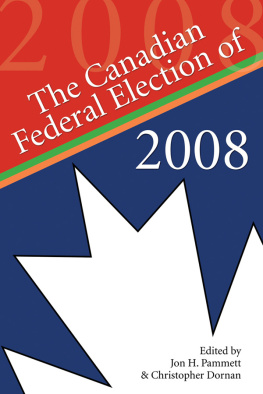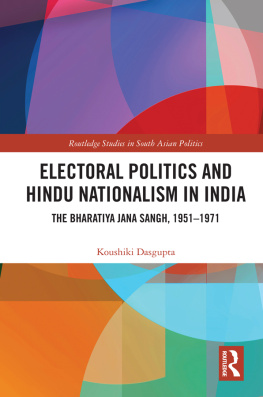DYNASTIES
and
INTERLUDES
DYNASTIES
and
INTERLUDES
PAST AND PRESENT
IN CANADIAN
ELECTORAL POLITICS
LAWRENCE LEDUC | JON H. PAMMETT | JUDITH I. MCKENZIE | ANDR TURCOTTE

Copyright Lawrence LeDuc, Jon H. Pammett, Judith I. McKenzie, Andr Turcotte, 2010
All rights reserved. No part of this publication may be reproduced, stored in a retrieval system, or transmitted in any form or by any means, electronic, mechanical, photocopying, recording, or otherwise (except for brief passages for purposes of review) without the prior permission of Dundurn Press. Permission to photocopy should be requested from Access Copyright.
Copy Editor: Allison Hirst
Design: Jesse Hooper
Printer: Transcontinental
Library and Archives Canada Cataloguing in Publication
Dynasties and interludes : past and present in Canadian electoral
politics / by Lawrence LeDuc... [et al.].
Includes bibliographical references and index.
Also issued in electronic format.
ISBN 9781554888221
1. Canada--Politics and government. 2. Elections--Canada--History.
3. Politics, Practical--Canada--History. I. LeDuc, Lawrence
JL65.D96 2010 320.971 C2010-902427-3
1 2 3 4 5 14 13 12 11 10
We acknowledge the support of the Canada Council for the Arts and the Ontario Arts Council for our publishing program. We also acknowledge the financial support of the Government of Canada through the Canada Book Fund and The Association for the Export of Canadian Books, and the Government of Ontario through the Ontario Book Publishers Tax Credit program, and the Ontario Media Development Corporation.
Care has been taken to trace the ownership of copyright material used in this book. The author and the publisher welcome any information enabling them to rectify any references or credits in subsequent editions.
J. Kirk Howard, President
Printed and bound in Canada.
www.dundurn.com
Dundurn Press
3 Church Street, Suite 500
Toronto, Ontario, Canada
M5E 1M2
Gazelle Book Services Limited
White Cross Mills
High Town, Lancaster, England
LA1 4XS
Dundurn Press
2250 Military Road
Tonawanda, NY
U.S.A. 14150
For Philip Converse, John Meisel, Maurice Pinard, Peter Regenstreif, and Mildred Schwartz principal investigators of the first (1965) Canadian National Election Study
CONTENTS
LIST OF FIGURES
LIST OF TABLES
PREFACE
The research and writing of this book has taken place over a substantial period of time and we have accumulated many debts, intellectual and otherwise, in the course of that work. We dedicate the volume to the group of pioneering scholars who carried out the first major survey of the Canadian electorate following the 1965 federal election. But we have also relied on similar studies conducted in all but one of the federal elections since that time, involving the work of many new generations of scholars.
These studies were supported by the Social Sciences and Humanities Research Council of Canada, and by its predecessor, the Canada Council, without whose funding they would never have been possible. Taken together, this body of social science research, spanning nearly half a century, provides a comprehensive picture of the changing nature of the Canadian electorate, in addition to critical insights into the attitudes and behaviour of voters in specific elections.
While this large body of survey material was central to our research, it is not the only evidence employed herein. For more than 20 years before the 1965 study, the Canadian Institute of Public Opinion (the Gallup affiliate in Canada) polled Canadians on a regular basis regarding their attitudes toward a variety of political and social issues. Together with the election studies, archives of these data provide a valuable window on the politics of that earlier time.
In the period before public opinion polling and survey research became established, we have relied more heavily on memoirs, biographies, and historical treatments of elections. John Meisels study of the 1957 election, for example, was described by its author as an exercise in contemporary history. This and other works contemporary to the various periods of Canadian political life that we seek to analyze in this book help us to better understand the evolution of our politics, and the social, political, and economic forces which drove the larger processes of change that we examine here.
Works on particular elections have proved invaluable to us in this research. From 1974 to 1984, Canada was included in the comparative series of books on elections edited by Howard Penniman and published by the American Enterprise Institute. Beginning in 1984, scholars based at Carleton University have published books on each election involving a collaboration between journalists and political scientists, bringing the unique insights of each field to bear on the election process and outcome. Since 1997, this series has been published by Dundurn Press, and has greatly expanded in its coverage of each successive election. Some of the work found in the 2006 and 2008 volumes of this series reflects ideas that were beginning to develop in the writing of this book.
We are grateful to the staff at Dundurn for helping us to bring this project to fruition, particularly Kirk Howard, Michael Carroll, and editor Allison Hirst. We also wish to thank Library and Archives Canada for providing some of the material for early chapters in this book, and for making it possible to include photographs of past electoral campaign activities. Thanks as well to Jean Marc Carisse for making available to us a number of his photographs from later periods. We are likewise grateful to Dan Hilton of the Conservative Party of Canada who helped us immensely in obtaining some of the more contemporary photos.
We owe a special debt to Allan Kornberg, Peter Russell, and Dennis Pilon, who read an earlier draft of this manuscript and provided much helpful feedback. We happily absolve them from any responsibility for errors of fact or interpretation that may remain in spite of their best efforts. That there are some, we have no doubt.
The goal of this project from the beginning has been to develop a broader theoretical understanding of the ebb and flow of Canadian electoral politics as it has evolved over a century and a half of Canadian democracy. The electorate has changed greatly over that period, as women gained the vote and the technology of electoral campaigns evolved markedly. Politicians of the nineteenth century would barely recognize the electoral campaigns of today. Yet, if they looked more closely, they would undoubtedly see similarities in the framing of economic issues, the concern with aspects of national unity, the reliance on party leaders, or the importance of Canadas relations with the United States.
Next page


